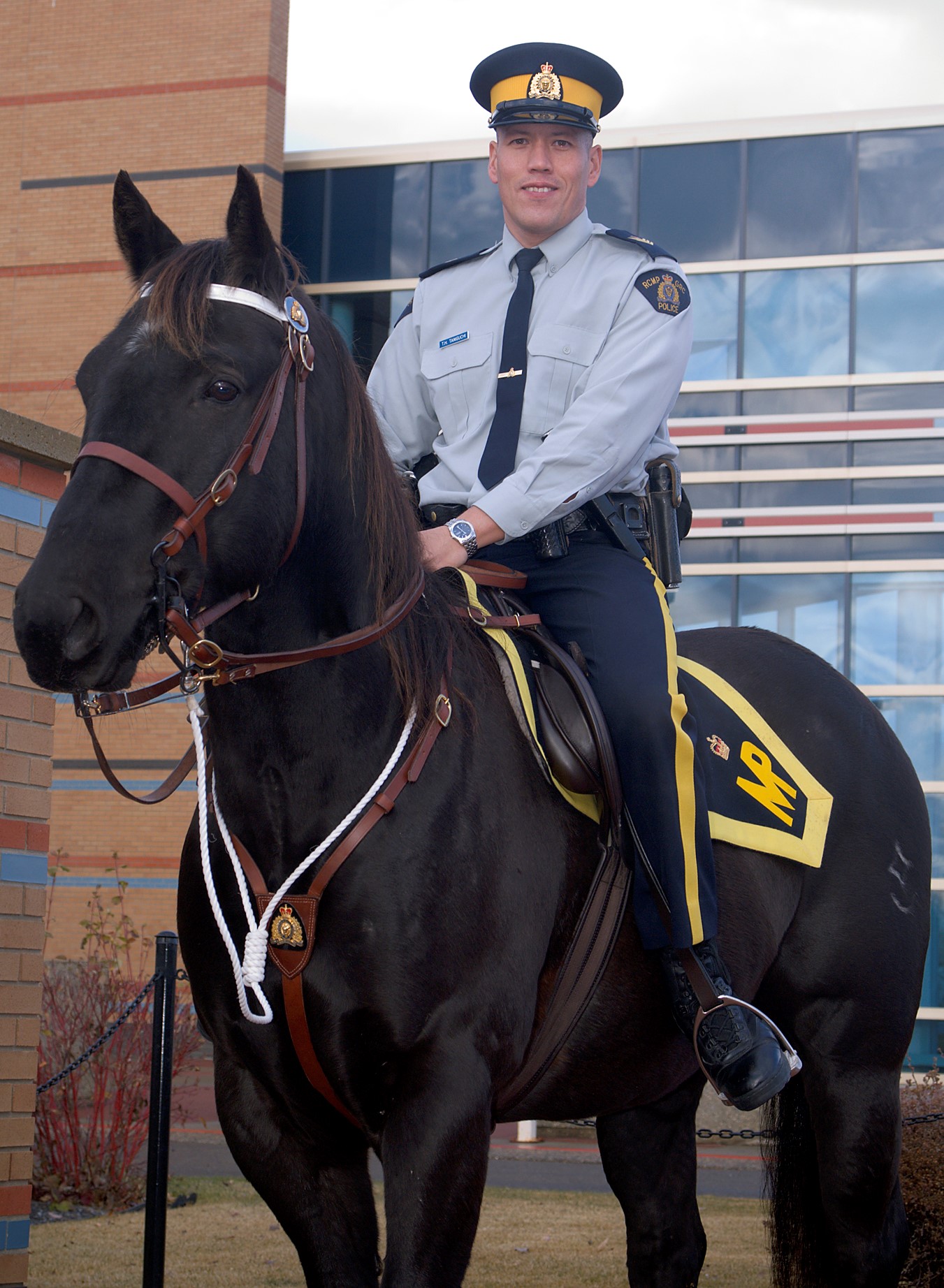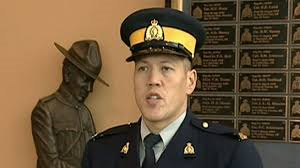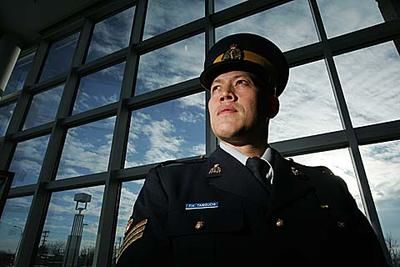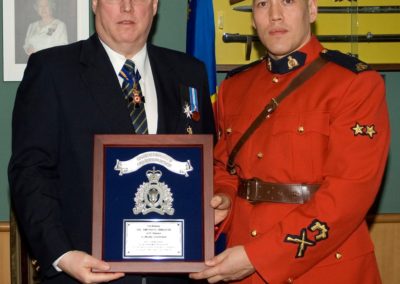Timothy Haruki Taniguchi

Home Town: Brooks, Alberta
Training Division: Depot
Troop: TR. 20 1995/96
Regimental Number: 45367
Divisions Served: “K”
Medals & Honours: Commissioner’s Commendation for Bravery, District Commander’s Certificate, Town of Slave Lake Medal, Queen’s Diamond Jubilee Medal, RCMP Long Service Medal, Alberta Long Service Medal, Alberta Emergency Services Medal
Pillar Location: Pillar XI, Row 12, Column A
Story:
Sgt. Tim TANIGUCHI grew up as a small town boy from Brooks, Alberta. He was influenced at a young age to join the RCMP by his junior high school basketball coach, Cst. John CALLANDER. He was impressed when he saw Cst. CALLANDER getting involved in the community by marching in the parades, coaching youth sports and influencing young people. He believed that this would be a great job as there would be a new challenge everyday.
In Grade 12, he wrote and passed the RCMP entrance exam; however in speaking with local RCMP members he decided to defer his RCMP application to seek a college degree in business management.
In 1994, he graduated from the University of Lethbridge with a Bachelor of Management and then continued his application into the RCMP which, unfortunately, was in a hiring freeze. In 1995, he was accepted into the RCMP and in December 1995 he travelled to Regina to “Depot” Division where he started his training with 23 other men and women from all over Canada. His first night was memorable as he lay in his bunk bed and listened to all the snoring from the senior cadets in the dorm room. He thought to himself – “What did I get myself into?”
Training in Depot Division was a challenge. Some of the things that stood out were the uniform swim wear (Mountie joke), the OC exposure, the CS gas exposure and the driver training. There were many times when he could not believe he was being paid to do these types of things.
In July 1996, he graduated from the RCMP Training Academy and travelled to Grande Prairie, Alberta for his first RCMP posting. As with most RCMP careers, his first posting was his favorite. He became good friends with many members and staff at the Detachment. He learned a variety of skills in General Duty policing and he was also given the opportunity to work in the General Investigation Unit and the Mountain Bike Unit. It was very exciting every time there was a pursuit, foot chase or dynamic arrest. When you are young you feel like a super hero and you can take on the world. Your first posting was always a time where you were exposed to new and exciting things which resulted in stories to your friends and family.
In July 1999, he married his university girlfriend, Jill Boyden. He proposed to Jill by conducting a traffic stop when she was returning from work as a school teacher. Unbeknown to him, someone at the Grande Prairie Detachment tipped off the media and a newspaper reporter arrived at the traffic stop during the marriage proposal. A photograph was published in the local paper with the title of “arresting proposal”. This was well before the internet and social media so luckily it only hit the local community.
In September 2001 he attended Regina to take the Instructor’s Course in the Public and Police Officer Safety Course (PPSC). The first day of the course was September 11, 2011. He remembered watching television in his dorm room as the planes struck the twin towers in New York City. The next day he was told that the course candidates may be sent to various cities to be interim air marshals as it was unknown if this was the last of the terrorist attacks. Fortunately, the course candidates were not sent and the course continued. He was successful in the course and he became a PPSC Instructor. Throughout the rest of his career he instructed on numerous PPSC Courses in Jasper, Suffield, Penhold and Edmonton.
In November 2001, he was transferred to the Edmonton Commercial Crime Section. He investigated numerous high profile frauds during his time in the section and became exposed to complex and major investigations. He also joined the part-time Emergency Response Team (ERT). He participated in numerous call outs and operations during his short time with ERT. On February 28, 2004 he was directly involved in an officer involved shooting which resulted in the tragic loss of the legendary police dog handler, Cpl. Jim GALLOWAY. This had a significant impact throughout his career and personal life. On the outside he was his normal, happy go-lucky self; however, on the inside he became withdrawn and lost his self-confidence. This became common themes to the end of his career.
In October 2004, he took a promotion to Corporal to his hometown of Brooks where he started as a Detachment Supervisor. In 2005, he was given the assignment to create a General Investigative Section (GIS) to deal with the growing drug and violent crimes that were appearing in the town. In the summer of 2005 a labour dispute began to develop between a union and Lakeside Packers, a local meat packing plant. As a result, in September 2005, he wrote an operational plan to deal with the pending labour strike. The operation brought in over 400 RCMP members and municipal police officers from Alberta and Saskatchewan. It included Special Tactical Operations (STO) Teams, ERT teams, Air Services and uniformed members. The labour strike lasted for a month and the RCMP’s actions during the strike were considered a success as the RCMP was able to balance the citizens’ rights to assemble/protest and public safety. The operational plan became accepted as a National best practice for the RCMP and contributed to the development of the “K” Division Emergency Operations Plan for Public Order and Operational Enforcement Plan.
In June 2008, he took his second bump to Sergeant to “K” Division Headquarters in the Community Policing Unit where he headed the portfolios of Diversity, Hate Crime, and Employment Equity. He also took secondary employment at the Grant MacEwan College where he taught a course in the Police Studies called “Policing in Canada”.
In June 2010, he was asked to go into the “K” Division Strategic Communications Unit. He became the media relations officer for the northern half of the province and the Acting Staff Sergeant for the unit. He was involved in a number of high profile incidents as the spokesperson including the Murders of Lyle and Marie MCCANN (2010), the Mayerthorpe Fatality Inquiry (2011) and the Slave Lake fire (2011). By far this was the most demanding and stressful position in his career.
In April 2012, he took the opportunity to transfer as a seconded RCMP officer to the Alberta Serious Incident Response Team (ASIRT) in Calgary. This was the last transfer he took while in the RCMP as he promised his wife, Jill and their two children, Joel and Claire that the family would stay at this posting for the long term since they gave up so much for his career from the previous physical moves. The transfer to ASIRT allowed him to gain experience in police oversight. He investigated numerous files involving police officers including incidents of use of force, fraud, theft, drug trafficking, perjury and sexual assault. It also allowed him to take his experience, being involved in an officer involved shooting in 2004 and apply it to officer involved shooting investigations. He was able to relate to the involved officers in a way that only few officers could. He spent 8 years in ASIRT, the longest time he spent in any unit.
In July 2020 he retired in order to explore other interests.
Throughout his career he masked the Post Traumatic Stress which was diagnosed after his shooting. The stigma of weakness, the embarrassment of his failure and his lost of confidence had an effect on his career and his personal life; however, he can say without a doubt that he has survived.
He would like other RCMP members and the public to know that police officers will be involved in incidents that will affect them and the best way to manage the stress is to talk to people, whether it be your spouse, friend, minister or psychologist.
His favorite quote which he believes applies to policing is from Theodore Roosevelt.
“It is not the critic who counts; not the man who points out how the strong man stumbles, or where the doer of deeds could have done them better. The credit belongs to the man who is actually in the arena, whose face is marred by dust and sweat and blood; who strives valiantly; who errs, who comes short again and again, because there is no effort without error and shortcoming; but who does actually strive to do the deeds; who knows great enthusiasms, the great devotions; who spends himself in a worthy cause; who at the best knows in the end the triumph of high achievement, and who at the worst, if he fails, at least fails while daring greatly, so that his place shall never be with those cold and timid souls who neither know victory nor defeat.”
Sgt. TANIGUCHI was awarded the following throughout his career:
• Commissioner’s Commendation for Bravery for an Officer Involved Shooting in 2004
• District Commander’s Certificate for his work during the Lakeside Labour Dispute in 2005
• Town of Slave Lake Medal in 2011 for the Slave Lake Fire
• The Queen’s Diamond Jubilee Medal in 2012
• RCMP Long Service Medal (20 Years) in 2016
• Alberta Long Service Medal (20 Years) in 2016
• Alberta Emergency Services Medal (12 and 22 Years) in 2020



